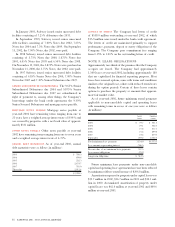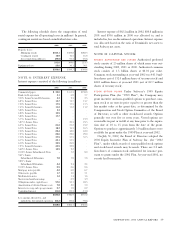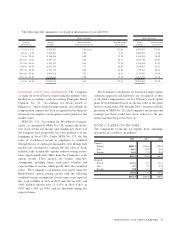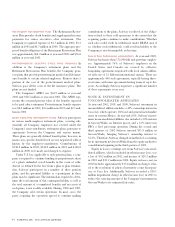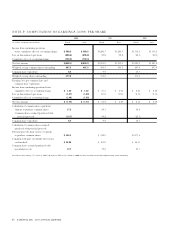Safeway 2002 Annual Report Download - page 46
Download and view the complete annual report
Please find page 46 of the 2002 Safeway annual report below. You can navigate through the pages in the report by either clicking on the pages listed below, or by using the keyword search tool below to find specific information within the annual report.
44 SAFEWAY INC. 2002 ANNUAL REPORT
RETIREMENT RESTORATION PLAN The Retirement Restor-
ation Plan provides death benefits and supplemental income
payments for senior executives after retirement. The
Company recognized expense of $5.7 million in 2002, $5.5
million in 2001and $4.7 million in 2000. The aggregate pro-
jected benefit obligation of the Retirement Restoration Plan
was approximately $64.2 million at year-end 2002 and $55.8
million at year-end 2001.
POSTRETIREMENT BENEFITS OTHER THAN PENSIONS In
addition to the Company’s retirement plans and the
Retirement Restoration Plan benefits, the Company spon-
sors plans that provide postretirement medical and life insur-
ance benefits to certain salaried employees. Retirees share a
portion of the cost of the postretirement medical plans.
Safeway pays all the costs of the life insurance plans. The
plans are not funded.
The Company’s APBO was $63.9 million at year-end
2002 and $58.5 million at year-end 2001. The APBO rep-
resents the actuarial present value of the benefits expected
to be paid after retirement. Postretirement benefit expense
was $8.0 million in 2002, $2.6 million in 2001 and $2.1 mil-
lion in 2000.
MULTI-EMPLOYER RETIREMENT PLANS Safeway participates
in various multi-employer retirement plans, covering sub-
stantially all Company employees not covered under the
Company’s non-contributory retirement plans, pursuant to
agreements between the Company and various unions.
These plans are generally defined benefit plans; however, in
many cases, specific benefit levels are not negotiated with or
known by the employer-contributors. Contributions of
$138.8 million in 2002, $144.9 million in 2001 and $140.8
million in 2000 were made and charged to expense.
Under U.S. law applicable to such pension plans, a com-
pany is required to continue funding its proportionate share
of a plan’s unfunded vested benefits in the event of with-
drawal (as defined by the law) from a plan or plan termina-
tion. Safeway participates in a number of these pension
plans, and the potential liability as a participant in these
plans may be significant. The information required to deter-
mine the total amount of this contingent liability, as well as
the total amount of accumulated benefits and net assets of
such plans, is not readily available. During 1988 and 1987,
the Company sold certain operations. In most cases, the
party acquiring the operation agreed to continue making
contributions to the plans. Safeway is relieved of the obliga-
tions related to these sold operations to the extent that the
acquiring parties continue to make contributions. Whether
such sales could result in withdrawal under ERISA and, if
so, whether such withdrawals could result in liability to the
Company, is not determinable at this time.
COLLECTIVE BARGAINING AGREEMENTS At year-end 2002,
Safeway had more than 172,000 full and part-time employ-
ees. Approximately 76% of Safeway’s employees in the
United States and Canada are covered by collective
bargaining agreements negotiated with local unions affiliat-
ed with one of 12 different international unions. There are
approximately 400 such agreements, typically having three-
year terms, with some agreements having terms of up to five
years. Accordingly, Safeway negotiates a significant number
of these agreements every year.
NOTE K: INVESTMENT IN
UNCONSOLIDATED AFFILIATES
At year-end 2002, 2001 and 2000, Safeway’s investment in
unconsolidated affiliates includes a 49% ownership interest in
Casa Ley, which operates 102 food and general merchandise
stores in western Mexico. At year-end 2001, Safeway’s invest-
ment in unconsolidated affiliates also included a 50% interest
in GroceryWorks, an Internet grocer, and a 15% interest in
FBO, a beef processing operation. During the second and
third quarters of 2002 Safeway invested $11.9 million in
GroceryWorks, bringing Safeway’s ownership interest to
52.5%. Therefore, Safeway changed its method of accounting
for its investment in GroceryWorks from the equity method to
consolidation beginning in the third quarter of 2002.
Equity in (losses) earnings, net, from Safeway’s unconsol-
idated affiliates, which is included in other income (loss), was
a loss of $0.2 million in 2002, and income of $20.2 million
in 2001 and $31.2 million in 2000. Equity in losses, net, in
2002 includes approximately $15.8 million in charges relat-
ed to the resolution of physical inventory count discrepan-
cies at Casa Ley. Additionally, Safeway recorded a $30.1
million impairment charge in other income (loss) in 2001 to
reduce the carrying amount of the Company’s investment in
GroceryWorks to its estimated fair value.






